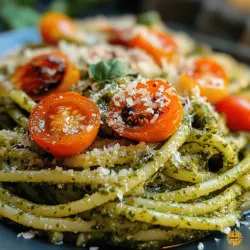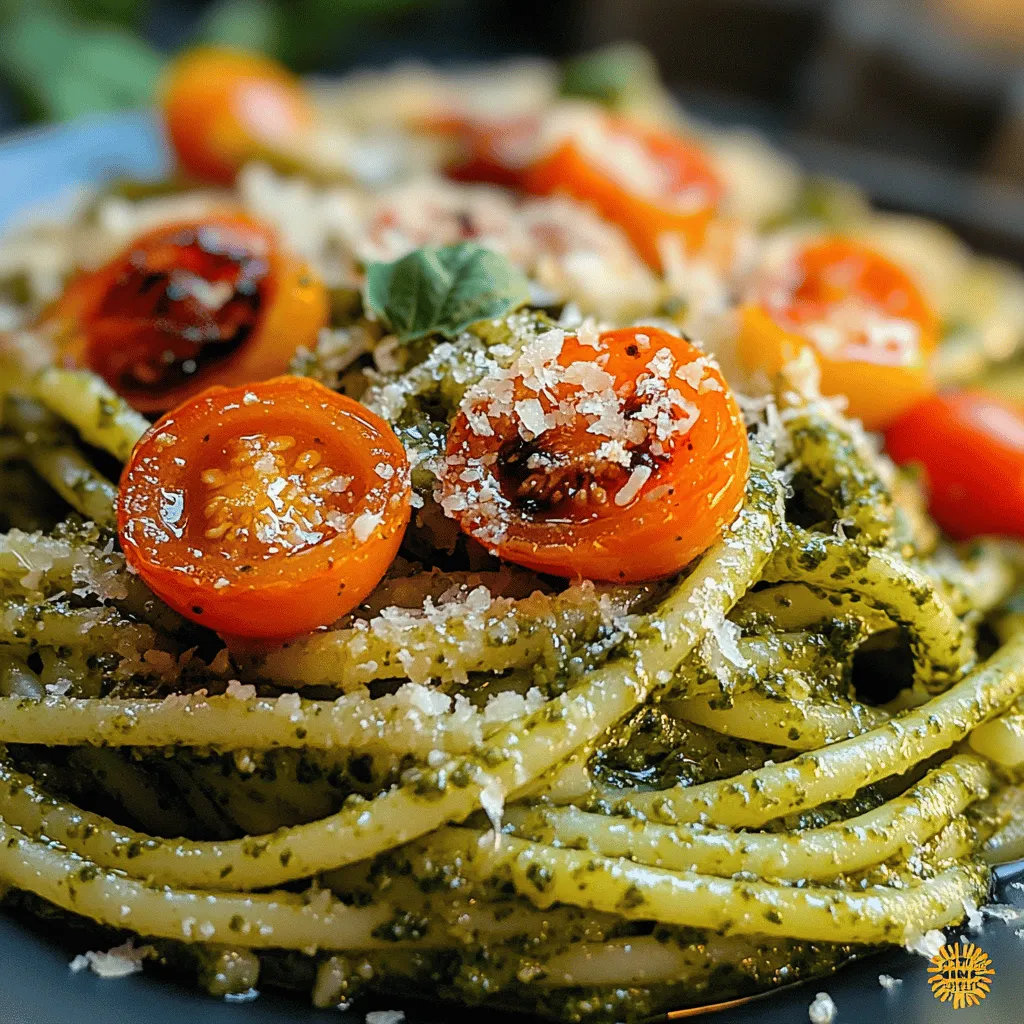Introduction
In recent years, homemade pasta dishes have surged in popularity, capturing the hearts and appetites of food enthusiasts around the globe. The appeal lies not only in the comforting embrace of fresh pasta but also in the ability to tailor flavors and ingredients to personal preferences. Among the myriad of pasta recipes, Basil Bliss Pesto Pasta stands out as a vibrant and fresh option that elevates your dining experience. This delightful dish combines the earthy richness of freshly made pasta with the aromatic essence of homemade pesto, creating a meal that is both satisfying and wholesome.
Basil Bliss Pesto Pasta is an ideal choice for those who appreciate the simplicity of cooking with fresh ingredients. With a few high-quality components, you can craft a dish that bursts with flavor and color, all while reaping the health benefits associated with its key ingredients. The use of fresh basil, nuts, and olive oil provides a nutrient-dense meal that is as delicious as it is nutritious.
Understanding Pesto and Its Origins
To fully appreciate Basil Bliss Pesto Pasta, it’s essential to delve into the history of pesto itself. Originating from the Liguria region of Italy, pesto is a traditional sauce made from crushed garlic, basil, and pine nuts, blended with olive oil and Parmesan cheese. The name “pesto” derives from the Italian verb “pestare,” which means to crush or pound, reflecting the traditional method of making this sauce using a mortar and pestle.
While the classic basil pesto is the most recognized version, many variations exist, showcasing a variety of ingredients beyond basil. For example, sun-dried tomato pesto adds a tangy sweetness, while spinach pesto contributes a vibrant green color and additional nutrients. Arugula-based pesto introduces a peppery kick, making it an exciting alternative for those looking to experiment with flavors. These variations not only showcase the versatility of pesto but also allow for creativity in the kitchen, accommodating diverse tastes and dietary preferences.
Nutritionally, basil is a powerhouse herb, packed with antioxidants and essential vitamins. It contains vitamin K, which is vital for bone health, and is rich in antioxidants that help combat oxidative stress in the body. Furthermore, basil possesses anti-inflammatory properties, making it an excellent addition to a balanced diet. By using fresh basil in your pesto, you not only enhance the flavor but also contribute to your overall well-being.
Ingredients Breakdown
To create Basil Bliss Pesto Pasta, it’s crucial to understand the role and importance of each ingredient, as they all contribute to the dish’s overall flavor and nutritional profile.
Fresh Basil Leaves
At the heart of this recipe is fresh basil leaves. When selecting basil, it is essential to choose high-quality, vibrant green leaves, as they provide the signature flavor of pesto. Fresh basil should be fragrant and free from blemishes; wilted or discolored leaves can detract from the dish’s overall taste. The aromatic oils in fresh basil are what give pesto its distinctive taste, so opting for the freshest ingredients will yield the best results.
Parmesan Cheese
Parmesan cheese plays a crucial role in enhancing the umami flavor and creaminess of the pesto. Aged Parmesan, with its nutty and savory notes, complements the brightness of the basil, contributing depth to the sauce. When making pesto, using freshly grated Parmesan ensures that you capture the full flavor profile, as pre-packaged cheese often contains anti-caking agents that can dull its taste.
Extra Virgin Olive Oil
The choice of olive oil is another vital component in this recipe. Opting for high-quality extra virgin olive oil not only enhances the flavor but also provides numerous health benefits. Rich in monounsaturated fats and antioxidants, extra virgin olive oil supports heart health and has anti-inflammatory properties. Its smooth texture helps to bind the ingredients together, creating a silky pesto that coats the pasta beautifully.
Pine Nuts
Pine nuts, while small, pack a punch of flavor and nutrition. These nuts add a creamy texture and mild sweetness to the pesto. When lightly toasted, they release their natural oils, intensifying their flavor and enhancing the overall taste of the sauce. In addition to their culinary contributions, pine nuts are also a good source of protein, healthy fats, and essential vitamins and minerals.
Garlic
Garlic is the aromatic element that adds depth to Basil Bliss Pesto Pasta. It provides a savory kick that complements the other ingredients perfectly. The key to using garlic in pesto is to strike a balance; too much can overpower the dish, while too little may leave it flat. Fresh garlic cloves are recommended for their pungent flavor and health benefits, which include boosting the immune system and promoting heart health.
Lemon Zest and Juice
To brighten the flavors of the pesto and balance its richness, lemon zest and juice are essential additions. The acidity from the lemon cuts through the creaminess of the cheese and olive oil, creating a well-rounded flavor profile. Lemon zest adds a fragrant citrus note, enhancing the overall freshness of the dish, while the juice adds a tangy brightness.
Optional Garnishes
For those looking to elevate their Basil Bliss Pesto Pasta further, consider adding optional garnishes such as cherry tomatoes and roasted bell peppers. These ingredients not only provide a pop of color but also enhance the dish’s flavor and texture. Cherry tomatoes add a sweet juiciness, while roasted bell peppers contribute a smoky depth, making each bite a delightful explosion of taste.
Step-by-Step Instructions
Now that we have explored the ingredients and their significance, let’s dive into the preparation of the Basil Pesto itself. Creating the pesto is a straightforward process that yields delicious results, and using a food processor allows for optimal texture and ease of preparation.
Preparation of the Basil Pesto
1. Gather Your Ingredients: Start by measuring out all your ingredients. You will need fresh basil leaves, grated Parmesan cheese, extra virgin olive oil, pine nuts, garlic, lemon juice, and zest.
2. Toast the Pine Nuts: To enhance the flavor of the pine nuts, lightly toast them in a dry skillet over medium heat, stirring frequently until they are golden and fragrant. This step is crucial as it brings out the nutty flavor, making your pesto even more delicious.
3. Blend the Ingredients: In a food processor, add the toasted pine nuts, garlic cloves, and fresh basil leaves. Pulse the mixture a few times to break down the ingredients.
4. Incorporate the Cheese: Next, add the grated Parmesan cheese to the food processor. Pulse again until all the ingredients are finely chopped and well combined.
5. Add Olive Oil: With the food processor running, slowly drizzle in the extra virgin olive oil. This will help emulsify the pesto and create a smooth, creamy consistency. Stop occasionally to scrape down the sides of the bowl to ensure everything is well mixed.
6. Adjust the Consistency: If the pesto is too thick, you can add a little more olive oil until you reach your desired consistency. The pesto should be thick but spreadable.
7. Season with Lemon: Once you have achieved the desired texture, add the lemon juice and zest. Pulse a few more times to incorporate the citrus, balancing the flavors of the pesto.
8. Taste and Adjust: Finally, taste your pesto and adjust the seasoning as desired. You may want to add a pinch of salt or a little more cheese for added flavor.
By following these steps, you’ll have a vibrant and flavorful basil pesto that serves as the perfect sauce for your pasta. The freshness and simplicity of this dish make it a perennial favorite among pasta lovers, allowing you to savor the essence of Italian cuisine right in your kitchen.
As you prepare to combine your freshly made pesto with pasta, you’ll find that this dish not only delights the palate but also nourishes the body. The next section will guide you through the steps of cooking the pasta and bringing the Basil Bliss Pesto Pasta together for a memorable meal.


